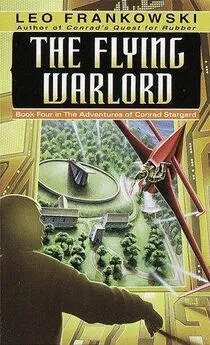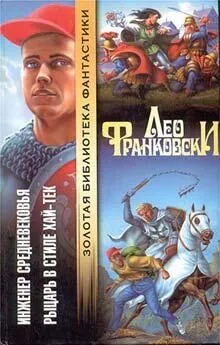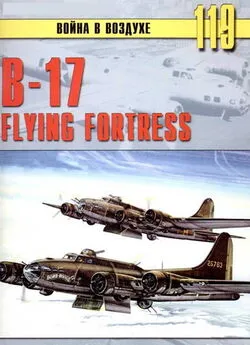Лео Франковски - The Flying Warlord
- Название:The Flying Warlord
- Автор:
- Жанр:
- Издательство:неизвестно
- Год:неизвестен
- ISBN:нет данных
- Рейтинг:
- Избранное:Добавить в избранное
-
Отзывы:
-
Ваша оценка:
Лео Франковски - The Flying Warlord краткое содержание
The Flying Warlord - читать онлайн бесплатно полную версию (весь текст целиком)
Интервал:
Закладка:
Games of this type put a premium on quiet motion, which wasn't easy in regulation plate armor. They naturally got to working on the armor. I told them that we could not possibly make new stamping dies, not this late in the game, so they worked within those limitations. What they came up with was a set of armored coveralls. It used the same pieces as our standard armor, but each piece fit into a sort of pocket sewn in the garment. Baggy when you first put them on, they had zippers up the sides and on all four limbs which snugged them up properly. Where the plate armor couldn't cover, as on the armpits and on the inside of the knees and elbows, pieces of chain mail were sewn in.
One of the beauties of this design was that you could get into it in a hurry. It took a quarter-hour for a man to arm himself with our standard armor. With Night-Fighter armor, it was a matter of a minute.
Another problem with any plate armor was that it didn't breath. Steel is impervious to air. This was no problem in the winter, when we normally wore quilted goose-down long underwear, but in the summer, you could suffocate in there, and cases of heat exhaustion and even heatstroke were all too common.
They worked out a system of forced ventilation. In the summer, you wore a set of thin linen long johns that had zippers all over the place. These zippers matched up with zippers on the inside of the armored coveralls. Since the armor was about a finger's width bigger than you were, all around, the result was a number of separate compartments all over you. The front of your shin was one compartment and the back of it was another. There were valves, simple flaps covering holes, at the knees and ankles, such that cool air could come in at the ankles and go out at the knees. As you walked, you naturally moved around inside this oversized armor, and this motion pumped cool air in the bottom and hot air out the top. Since there were eighteen of these compartments around your body, you stayed reasonably cool. Not like you'd be in a pair of shorts and a T-shirt, but cases of heat exhaustion became rare.
They did talk me into a summer helmet, which resembled a Chinese coolie hat, and we tooled up for that.
Their system was so superior to what we had that I made it the army standard, for the men anyway.
There wasn't much to setting up for the new armor. A number of conventional knights were looking for something for their peasants to do as a winter money-maker, so we set them up sewing armor coveralls.
I'd originally issued the same armor to the women that I had to the men, but the girls didn't like it. It had to be of the same thickness as the men's or it wouldn't be able to stop an arrow, and they said it was too heavy.
Since they would be fighting only from the walls, where the parapet protected them from the waist down, they soon discarded the leg armor. They said that the gauntlets made it hard to operate a gun, so they got rid of them, too. But the man's sword had only a small hand guard, about what you'd find on a Japanese sword, since the men wore steel gloves. Without authorization, the girls got the shop to tool up a special big hand guard, like they put on a modem epee.
And the standard breastplates. No style at all! Completely without my permission, special tooling was made, thirty-two expensive dies in all, just to satisfy them.
Now their breastplates had breasts on them.
And having done that, they thought that it was prettier polished and shiny, so they didn't go the practical coverall route. They'd even come up with a zowie-looking helmet with a Greek-style crest on it when I put my foot down. There was no face guard, and it didn't protect the neck at all, since the girls wanted their hair to show! I ranted and swore that this was a stupid design and a stupider waste of resources. They said. yes, sir. You're right, sir. We'll do it your way, sir.
Then two months later they were all wearing these new helmets!
I never could find out who made the dies, since they knew I would have fired the bastard, and the production schedules on the stamping presses showed no time allotted to the silly things. How they got them made, I don't know, but soon the ladies at all the other installations were in the new outfits, too.
But you try holding back a bunch of women when they get a bright idea.
Then to top it all off, the duke saw the ladies' helmets and thought that, gold-plated, they'd be just the thing for a ceremonial guard! I managed to talk him out of it. They wouldn't have fit a man, anyway, a female's head being much smaller than a male's. Darned if I was going to let any more draw dies be made.
Strange to say, despite its obvious advantages, the new coverall armor didn't catch on with the conventional knights.
Of course, during all this time, we'd been selling plate armor at decent prices to anyone who wanted to buy from us. Well, we wouldn't have sold to a Mongol, but none of them applied. But after three years of selling polished plate armor, it was all the rage among the hawking and hunting set. While our troops were discovering camouflage paint, they wanted to shine. There was nothing we could do about it, so we let them have their own way.
Another thing the Night Fighters did was with the swivel guns. They put a big pie plate of a flash suppressor at the muzzle of the gun. This did two things for them. For one thing, it stopped the muzzle flash from blinding the gunner at night. For another, it reflected all of the light forward, and they worked out a system where each gunner fired just after the man to his left. This let him aim by the flash of light caused by the last gun going off. From a distance, it looked like a string of chase lights on a theater marquis, but they got reasonably accurate with the system. Flash suppressors soon became standard for all our swivel guns.
Innovation was the name of the game at Eagle Nest, where a sturdy band of very young men were busily conquering the skies. Actually, they were getting too innovative, and I had to work at converting their efforts from research to production.
They had started out with motorless sailplanes, and their aircraft showed that heritage. The wings were long and thin, the bodies long and sleek. They were all highwinged, since I'd always been aiming at observation craft, and even with motors, they still had to be catapult launched.
This catapult was built on top of an ancient, manmade hill about six dozen yards high, probably some sort of prehistoric defensive structure. The hill was conical, with a flat spot on top about two dozen yards across. We built a low, circular concrete wall, and the catapult rode on this wall, so as to point into the wind. The catapult itself was a wooden ramp, six dozen yards long and angling upward at a half-hour angle. A rope ran from the back of the catapult to a pulley at the front, then back halfway to the center where it went over another pulley and then was attached to a massive concrete weight that was hung over a well we'd dug in the hill.
To launch, a plane was hauled up the hill and loaded onto the catapult. Then four dozen boys walked up to the front of the catapult, grabbed the rope, and hauled it back to the plane. With practice, they got so they could launch a dozen planes an hour this way.
But instead of building a few dozen planes of the best design we had and "fine tuning" them, they wanted to continue designing whole new ones. Part of the problem was that I'd once mentioned that a canard-type plane, with the propeller in back and the elevator forward of the wing was more efficient than the conventional design, but that these planes were too difficult for us to design and fly. The boys took that as a challenge, and Count Lambert was on their side. It took me three temper tantrums, and them four deadly wrecks, before they went into production on a standard, conventional aircraft.
Even with that, crack-ups were so frequent that they rarely had three planes ready to fly at any one time, and the price they willingly paid in lives still gives me nightmares.
Chapter Nine
About this time, we began to notice that there wasn't enough money to go around. I don't mean that we were spending more than we made. Far to the contrary! Our products were being sold all over Europe, and the local currency had become a hodgepodge of pennies, deniers, pfennigs, and what have you, minted in dozens of different places. In theory, all these coins were of the same value, but in fact, their weight and silver content varied all over the map.
But despite this influx of foreign coins, there still wasn't enough to go around. I was converting Poland from a barter economy to a money economy. Peasants who had rarely needed or even seen money in their lives suddenly found that they wanted money to buy the things we sold, and that they could get money by selling their crops, now that the railroads and steamboats were operating and they could get those crops to market. The lack of silver coin was causing a serious deflation, and the prices of things were dropping precipitously.
I, of course, had all kinds of money, and at first I tried to counteract the deflation by raising the pay scales of the people who worked for me. I kept the bottom rate the same, a penny a day, since we always had a waiting list to get in, even with the military-training requirement. But after that, pay doubled with each promotion. There were three grades of non-managerial workers, warriors, pages, and squires, earning one, two, and four pence respectively, and from then on, well, a man could get rich working for me.
But it didn't help the deflation a bit. Most of the extra pay was spent in my stores and my inns, or left in my bank. Very little of it got out to the general public.
Then I tried buying things I didn't really need, mostly land. I started buying up land along the rivers because I had some vague ideas of one day building a series of forts along them. But not that much land was for sale, and buying land was not as easy as it would be in the twentieth century. There were all sorts of encumbrances involved, oaths of fealty, requirements of military service, the rights of the peasants living there, strange taxes, and what not. I managed to get out of most of these-but not peasants' rights-with one-time cash payments, yet it did not cure the major problem that I was trying to solve. When I bought land from some nobleman, he usually spent the money to buy the things that my factories were making! He wanted arms and armor, glass windows, and indoor plumbing. The money came right back to me and the deflation continued!
Furthermore, I couldn't resist making the land I'd bought productive and profitable.
Surely, this was a problem that no capitalist ever had to cope with!
Charity work was another matter. With the assistance of Abbot Ignacy and his monks, I worked hard at helping the poor. We set up soup kitchens in the major cities and a large leper colony on an isolated estate that I'd bought. But the engineer in me hates waste, and the waste of human potential is the worst sort.
Many of the poor were that way simply because they could not find honest work, so I gave it to them. I set up non-army construction groups to build railroads and bridges. They were supervised by army personnel, of course, since there weren't many trained, technically competent people outside it. We were running tracks as fast as the blast furnaces could cast them, and most of our lines were double-tracked, so we didn't have to worry much about scheduling. With a single-tracked line, you have to make sure that a train isn't coming north before you take yours south. Double tracks can be treated just like a highway.
Some of the poor were children, orphans. We set up an adoption service, and many of these kids were adopted by army families. Some of the poor were old or feeble. In the cities we set up factories that turned out knitted goods, much of which were bought by the army. We always needed socks and underwear.
Читать дальшеИнтервал:
Закладка:




![Джордж Ланжелан - Муха [= Муха с белой головой / The Fly (La Mouche)]](/books/290346/dzhordzh-lanzhelan-muha-muha-s-beloj-golovoj-the.webp)



![Джеймс Купер - Пионеры, или У истоков Саскуиханны [The Pioneers, or The sources of the Susquehannah]](/books/1066142/dzhejms-kuper-pionery-ili-u-istokov-saskuihanny-t.webp)

